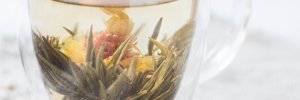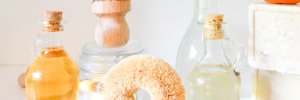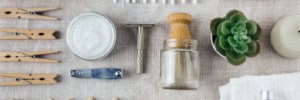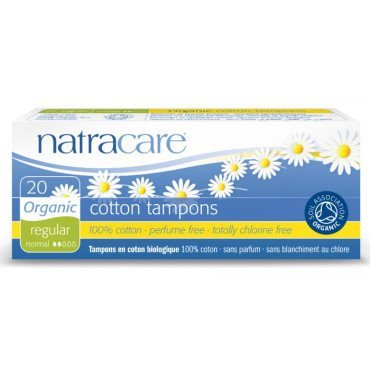Organic tampons NORMA Natracare, 20 pcs
Organic tampons NORMA Natracare, 20 pcs
Without applicator, for moderate discharge. The cotton swab increases in width.
- 100% organic cotton
- Not chlorine bleached (TCF certification)
- No plastic, viscose, fragrances, lubricants
- 100% biodegradable, non-polluting
- The world's # 1 brand for organic feminine hygiene products
Why organic tampons?
Natracare tampons were developed in 1989 out of concern about the damaging effects of dioxin (released when bleaching with chlorine), synthetic rayon in mass-market tampons, and pesticides (used in large quantities in conventional cotton growing).
Many women are unaware that rayon (rayon) and cotton / rayon blends are widely used in the manufacture of tampons. Viscose is usually chlorine bleached and is an extremely absorbent fiber. Dioxin, a toxic carcinogen by-product of chlorine bleaching, also occurs naturally through the use of pesticides.
It was found that dioxin can accumulate in the fatty tissues of animals and humans. According to scientific research, even low levels of dioxin are associated with cancer, endometriosis, decreased sperm count, and suppression of the immune system. A woman can use up to 11,000 tampons in her lifetime, which increases the risk of exposure to dioxin.
Natracare tampons are made exclusively from 100% organic cotton, not bleached with chlorine. Women can be assured that the tampons do not contain synthetic materials (such as rayon) or chemical additives (such as binders and surfactants).
Composition: 100% organic cotton. Individual packaging made of recyclable polyethylene. Recycled paper outer packaging.
Manufacturer: Bodywise, UK.
Manufacturing facilities: UK.
Distributor: Private Enterprise "Victoria", Ukraine, Kiev, st. Magnitogorskaya 1E, +38 044 502 60 33, +38 067 324 84 64.
An intimate question - natural feminine hygiene
The history of feminine hygiene products goes back thousands of years. Women have shown miracles of ingenuity to ease their "critical days".
Wealthy women from Egypt, Syria and Babylon preferred the first tampons, which were rolls of soft papyrus. Those who were poorer had to be content with tougher reeds. Ancient Greek women used homemade tampons made either from rolled fabric or from a round wooden rod covered with absorbent material. The ancient Romans used more gentle, in terms of tactile sensations, predecessors of tampons - rolls of soft wool, slightly greased. On the African continent, the soft parts of young bamboo were popular.
In medieval Japan, China, India, feminine hygiene was set very high. It was in Asia that disposable pads were first introduced. Asians used disposable paper napkins, folded in an envelope. Such an envelope was held in place by a handkerchief attached to the belt.
But European women preferred the prototype of the modern liner, and during menstruation wore an ordinary cloth bandage, folded several times and pinned to the belt of the skirt.
In the USSR until the end of the 80s. industrial tampons did not exist at all, and industrial pads were occasionally sold in pharmacies under the name "hygiene product." But in each book for schoolgirls, it was explained in detail how to make cotton pads wrapped in gauze. This "know-how" was perfectly mastered by all Soviet women.
The advent of disposable pads and tampons was a real breakthrough in human history. Comfortable, hygienic and soft - they are firmly entrenched in modern life. However, more and more gynecologists associate irritation, thrush and other disorders of the vaginal microflora with the use of mass-produced pads. The unfavorable effect of modern pads is due to the synthetic materials from which they are made.
Plastic wraps
On average, every woman has 450 periods in her life, most often accompanied by the use of disposable pads and mass-produced tampons.
Mass-produced feminine hygiene products contain chemicals that are harmful to the environment and our body:
- by-products of chlorine bleaching. To achieve a snow-white surface, pads and tampons are bleached with chlorine, a by-product of which is dioxin. As a carcinogen, dioxin also occurs naturally through the use of pesticides. It was found that dioxin can accumulate in the fatty tissues of animals and humans. According to scientific research, even low levels of dioxin are associated with cancer, endometriosis, decreased sperm count, and suppression of the immune system. A woman can use up to 11,000 tampons in her lifetime, which increases the risk of exposure to dioxin. In addition, the chlorine bleaching process is harmful to the environment by highly polluting the water.
- synthetic covering in contact with the body. Even those pads that position themselves as "natural" contain "soft as cotton" artificial fiber - viscose, and not cotton at all, as the buyer might assume. Viscose is usually chlorine bleached and is an extremely absorbent fiber. All leading brands of feminine hygiene products make viscose tampons. In addition, this synthetic material does not degrade (think of floating tampons on the banks of water bodies).
- the plastic layer creates conditions for the development of bacteria, promotes the penetration of pathological microflora from the intestine into the genitals. Plastic is obtained by oil refining, does not decompose and is harmful to the environment.
- absorbent polyacrylate gel. This transparent (or tinted) absorbent gel is popular with panty liners in their advertisements and can be harmful to health and cause irritation. It is a synthetic material derived from petroleum.
- other artificial additives: synthetic flavors, colorants, surfactant binders, lubricants. When interacting with synthetic pads, the emissions acquire a strong odor, which manufacturers try to mask with artificial flavors.
Natural alternative
An easy way to avoid dioxins, chemicals and reduce non-degradable waste after using synthetic pads and tampons is to switch to natural hygiene products made from organic cotton bleached without chlorine. Try Natracare Natural Pads and Tampons and you won't want to go back to synthetic ones again.
Natracare is a premium natural feminine care product. Products of this brand are on average 15-20% more expensive than their counterparts and better in quality. Since 1989, the company has been offering a wide range of products that include various types of organic tampons, organic sanitary napkins and other products for women who are concerned about their health. Today Natracare products are represented in more than 50 countries around the world, including Ukraine.
The tampons are certified organic 100% organic cotton. Feminine sanitary pads are made only from natural materials, do not contain fragrances, plastic or other additives, and are not bleached with chlorine.
Check the quality of your tampons
Do this test. Take two glasses of water. Place a regular swab in one, and a Natracare swab in the other. After 5-10 minutes, pull a regular tampon several times by the cord: it will seem to disintegrate, some villi will fall to the bottom. The Natracare tampon will hold firmly. This is due to the fact that bulk tampons are made of viscose, when soaked and when removed, they lose fibers. Residual fibers can trigger the growth of microbial colonies. Unlike viscose, cotton has a strong wavy structure and retains the fibers. A video of the experience can be viewed here. I recommend watching it, as it only lasts a couple of minutes, and the impression will be. Link video: What's in your tampons?
The pads are composed of organic cotton (not bleached with chlorine, no pesticides used in growing cotton that are abundant in conventional cotton), cellulose (not bleached with chlorine, obtained from FSC certified wood pulp), corn starch (waterproof breathable material obtained from from non-genetically modified corn, biodegradable).
Check your pads for polyacrylate absorbent content
Wet the pad, cut along the center line of absorption and look carefully to see if the clear (or tinted) droplets are protruding as a gel? It is a polyacrylate absorbent of petrochemical origin. It is believed that it can provoke irritation.
Despite the fact that the pads do not contain polyacrylate absorbent, the absorbency is high: the pads should be changed every 3-4 hours, tampons 4-6 hours. Natracare products are naturally biodegradable and environmentally friendly.
Many UK gynecologists recommend that women with sensitive skin use Natracare pads to reduce contact with chlorine bleached materials and products containing synthetic additives and petrochemical superabsorbents.
Using Natracare Natural Pads and Tampons includes:
- prevention of female dermatitis
- protection against allergic reactions
- termination of contact with harmful chemical compounds
- making a positive contribution to your health and the environment
Overall, Natracare Natural & Organic Feminine Hygiene products are a must have for women with sensitive skin, allergies and irritations, and all other women who care about their health and the environment.
Anastasia Le Hak, specially for Green Pharmacy magazine # 30









